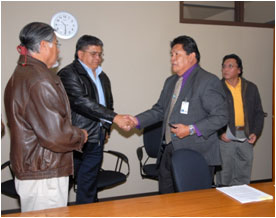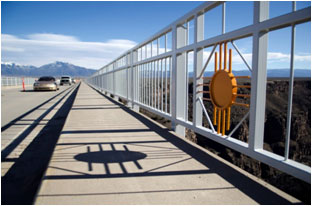NEW MEXICO DEPARTMENT OF TRANSPORTATION
Tribal Liaison Program
Program Description

New Mexico DOT Tribal consultation meeting.
(Source: New Mexico Department of Transportation.)
Program Benefits
- The Tribal Liaison Program has helped Tribes understand and participate in the transportation planning process.
- New Mexico DOT’s (NMDOT) planning program facilitates the early identification of areas of cultural and historical sensitivity, which streamlines the subsequent project development process.
- The NMDOT Planning Division provides technical assistance to local governments during project planning by conducting a preliminary environmental evaluation, which includes historic preservation factors. This early evaluation is used to assess the level of environmental review that will be needed for local projects.
- There is a greater understanding among Tribes of how to present their needs and meet the State planning and development requirements. Departments within the NMDOT also have become more aware of Tribal needs and concerns.
Tribal consultation has been a part of long-range transportation planning in New Mexico since 1999; however, no individual staff member was responsible for these consultation efforts. A Tribal liaison position was created in 2003 within the Department’s Strategic Planning Bureau. The position was filled in 2005 in response to: 1) SAFETEA-LU’s requirements for consultation with Tribes during transportation planning; and 2) an executive order from then Governor Bill Richardson, encouraging state agencies to consult with Native American communities in the State.
Concurrent with the creation of the Tribal liaison position, the New Mexico Department of Transportation (NMDOT) added historic preservation issues into the State’s Long-Range Transportation Planning (LRTP) process. At this time, NMDOT also adopted measures with local planning organizations to ensure that Tribal consultation was included in the planning process. Tribal representatives are members of Metropolitan Planning Organizations (MPO) and Regional Planning Organizations (RPO) whose jurisdiction lies immediately adjacent to Tribal lands. As members of these local planning organizations, the State’s 22 resident Tribes have an opportunity to raise concerns about the effects a project may have on historic resources, including properties of religious and cultural significance to Tribes.
Setting Up the Program
The New Mexico Cabinet Secretary of Transportation created the Tribal liaison position as a full-time employee using State Planning and Research (SPR) funds. The first Tribal liaison position was held by a non-Native American, who left the job after one year. In 2006, NMDOT hired a former Tribal governor of Acoma Pueblo to fill the liaison position.
Challenges Encountered
The Cabinet Secretary of Transportation created the Tribal Liaison Program, in part, in response to systemic concerns and needs within the Department regarding communication and coordination with the Native American community. Once a commitment to establish the position was made, the only issue to resolve was filling the position.
Program Maintenance
Program Elements
- Historic Preservation
in Transportation Planning
- Interagency Cooperation
and Collaboration
- Process for Tribal Consultation
No changes have been made to the Tribal Liaison Program since it started five years ago; however, the scope of the position has expanded. The liaison staff member has more committee assignments, for example. As a result, there is a need for some assistance within the Tribal Liaison Program to address the needs of the 22 Tribes within the State, but obtaining this assistance is difficult under the State’s current financial situation.
Funding for the Tribal Liaison Program, as well as the Strategic Planning Division of which it is a part, is still funded using SPR dollars.
Critical Factors for a Successful Program

Zia symbol cast on bridge over the Rio Grande Gorge,
Taos New Mexico.
(Source: Jake Schoellkopf,
New Mexico Department of Transportation.)
The Program is supported by NMDOT management. There is a recognized need for the kinds of services that the Tribal liaison provides.
One-to-one communication is key to the program’s success. The liaison is able to meet with Tribal representatives, identify issues and concerns, and convey these to Departmental staff. When government-to-government meetings are needed, these can be easily arranged. The Tribal liaison is able to provide guidance on both the policy level and on the level of individual transportation projects; he is the go-between for the Tribes and NMDOT.
The job of the Tribal Liaison Program is to build relationships between the NMDOT and the Tribes and then to help maintain that relationship. The Tribal liaison helps the Tribes and NMDOT to work together.
One of the lessons learned about this program is that more outreach is needed at the level of the individual Tribes and not just at the MPO and RPO levels.
June 1, 2012

